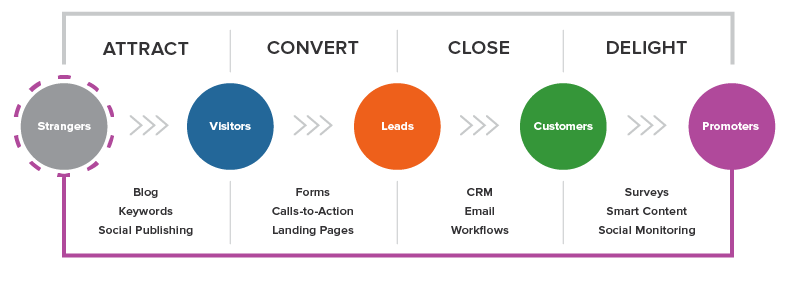Google has made some hefty changes to their algorithm that has altered the way marketers spend time to optimize websites and increase ranking in search engines. Recently, I’ve found myself educating other business owners and marketers on how SEO or search engine optimization has changed over the last 18 months.
In recent Google algorithm updates, Google has diminished the power of inbound links and placed a high importance on content and overall user experience. Increasingly, this is the direction that Google is moving toward.
Let’s take a look at why search is so important to businesses looking expand their reach (and why ignoring it is no longer an option) and how to ensure your company shows up when buyers are searching for your product or service.ele
Why is search engine optimization important?
It used to be that the seller was in control of the buying process. We told prospects what we sold, how we delivered the product, what customers we worked with, and could selectively point them to our best clients. Today, the buyer is in control of the buying process – in fact – over 60% of a sale is over before a sales person knows the prospect is in the market to buy. So what’s happening? The buyer is combing your website (and your competitors’ sites), reviewing your connections on LinkedIn, learning about who else you’ve helped, reading reviews and getting input from people in your mutual network about their experiences. All before you even know who they are.
How does Google work and what has changed?
Curious to know why the discussion around the importance of corporate blogging hasn’t died down? Why your Flash website has to be completely reprogrammed to be compatible with search engines? Or why inbound marketing has gained so much momentum? Let’s take a look at How Google works (in layman’s terms) and what you can do to keep your website on the top of Search Engine Results Pages (SERPs).
First and foremost, the technical aspects of your website have to be such that Google’s crawlers can index your website’s pages. If your website is completely written in Flash or is made up entirely of images – it’s time for a makeover.
Second, on site content – this refers to pages that are within the root domain of your website. They must contain relevant, frequently updated information about the products and services your company sells and the problems you solve for your customers. This is your opportunity to let Google know the topics for which you are an expert. For example – at Element Three, we write on our website about Inbound Marketing, Marketing Strategy and Brand– so we have pages on our website and within our blog that talk about these topics – and we talk (errr… write) about them a lot. Google looks at depth (how much content do you have on a particular topic), frequency (how often do you write) and recency (how much time has elapsed since you last posted a blog or added content to your website) when deciding what pages to serve up search results on search engine result pages (SERPs) for users.
Last, is off site content – or inbound links. This is the part that has changed significantly. Google’s algorithm used to place the most credibility on inbound links – essentially other websites providing a direct link to your website. As with many things in marketing – the pendulum has a tendency to swing to an extreme. Link-building is still important – but should be given focus only to those inbound links with the highest credibility and industry relevance. For example – at Element Three, we would be searching for links from HubSpot.com and other places that marketers might go to find helpful information about inbound marketing.
Lost in all of this lingo? Focus on producing high-quality content that your target audience loves – and the rest takes care of itself.
For a more detailed explanation of how to get inbound marketing to grow your business – read on.
How does Inbound Marketing help my company get more customers?
Ninety percent of business to business buyers say that when they’re ready to buy, they’ll find you. Yet most traditional marketing focuses on pushing messages out into the marketplace to find customers. This is called outbound marketing. It includes techniques like cold calling, advertising, trade show displays and direct mail campaigns (usually sent to purchased, untargeted lists). These outbound marketing efforts are designed to interrupt people, not to inform them.
Inbound marketing flips outbound marketing completely around. It meets your prospects and customers at the moment when they need information on a specific topic – instead of interrupting their world. Interested in initiating an inbound marketing initiative in your organization? Here is an outline of the steps to get started:
1. Generate website traffic
Generating traffic to your website is key to starting a successful inbound marketing effort. Most companies lack new site visitors, so efforts must begin here. Using compelling top of the funnel content (like white papers and how-to papers), creating frequent blog posts (like 15+ a month), email marketing to activate your network, and participation in social media like LinkedIn Groups and Twitter will help to expand your reach among qualified customers.
2. Convert website traffic into leads
With special offers, e-books, white papers, events and webinars, you must create offers that are enticing to your target audience. Instead of giving information away for free, ask your website visitors to fill out a short form with their contact information in exchange for the information. Visitors who identify themselves by filling out a landing page form are then treated as leads.
3. Convert leads into customers
Though not every lead that comes through your website is ready to buy that moment, the goal of inbound marketing is to convert leads into paying customers. To keep your brand – and product or service – top of mind as prospects moves through the sales funnel, implement an email lead nurturing effort. Concerned it will work? Nurtured leads have a 23% shorter deal time and a 9% higher average deal size compared to non-nurtured leads.
Measure
If you care about your marketing ROI (and we’re betting that you do), then you must be willing to invest in the measurement tools that help us refine and perfect your inbound market efforts. At Element Three, we use a powerful, integrated software tool – HubSpot.
With HubSpot, we can tell you, in real-time, how many visitors are coming to your site, where they’re coming from, exactly who’s converting into a lead and who’s converting into a customer. We can determine your highest impact marketing areas, and which marketing tactics you should stop investing in immediately. We can alert your sales team when top prospects return to your website. It’s true. We do it every day.
Key Takeaway:
Stop spending all of your time on key word research and discrete SEO efforts. Reward your network with content that educates, delights and makes them smarter at their jobs – and you’ll have a bigger following, more leads, and more customers to show for it.
[imageCTA title=”Go beyond inbound marketing” summary=”Your inbound marketing efforts can’t stand alone. Learn how we help our clients to create comprehensive strategies that span the marketing landscape.” link=”elementthree.com/contact” button=”Let’s Talk” image=”e3_inbound_marketing_cta.jpg” layout=”image_left”]






